Gymnastics: Facts | Information | Pros and Cons
What Is Gymnastics
Gymnastics is a sport in which a performer called a ‘gymnast‘ perform acrobatic feats, leaps, flips, turn, handstand, and more. Gymnasts use different pieces of apparatus such as a balance beam, floor, rings, bars, rope, and ribbon.
OR
It is an exercise demonstrating physical activity and coordination. These exercises are practiced on bars, floors, balance beams, vaulting horse, rings and pommel horse etc.
History
The word is derived from Greek words’ gymnast means naked. Most aerobics competition has done in the nude in Ancient Greece. First-time gymnastics officially held as a sport in 1862 through United State. In 1896 first time it was introduced in the Olympics.
This is an old sport which changed with the passage of time and first time included in the Olympics as a modern game in 1896. The earliest Olympic competition was based on all male participants and they competed on the event like parallel and high bar in addition to that rope climbing use to consider as a special event back then but nowadays it completely obsolete.
First-time Olympic competition held in 1928.
Table of Contents
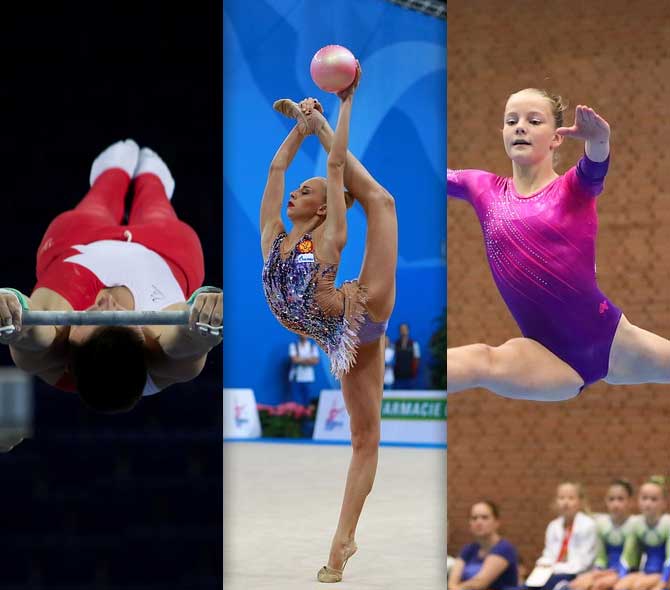
Types of Gymnastics
According to the current Olympics, it has three types of features.
Artistic
Artistic is a sport in which both men and women compete on some pieces of equipment like uneven bars, parallel bars, horizontal bars, vault, pommel horse, floor exercises, balance beams, and still rings.
Rhythmic
In Rhythmic, gymnast use on same floor mat by using ribbon, ropes, hoops, and other pieces of equipment as their parts of routines.
Trampoline
Trampoline gymnasts perform routines on a trampoline and complete flips on every single bounce. It was introduced Olympic discipline for 2000 Olympics.
Gymnastics Events
Men and women act upon on a different piece of equipment.
Men perform on high bar, parallel bar, vault, pommel horse, still rings, and floor exercises.
Women carry out these sports on an uneven bar, vault, balance beams, and floor exercises.
Who can do Gymnastics?
It is the sport that focuses on stability, flexibility, and essence strength which all things essential for healthy living. It is beyond anyone ages and gender.
Anyone can do aerobic, but it takes hard exercise, dedication, discipline, and sacrifices to make it top level as an elite gymnast.
Are There Benefits Of Doing Gymnastics?
It is a fantastic sport and has a lot of benefits to all individual involved that are physical, developmental, and emotional.
- The biggest benefit of it is that body come in the great shape.
- It can improve confidence level.
- Children especially come out from their shells and may connect with other fellows by doing aerobics.
- It teaches responsibility and goal setting.
- Due to the hard training, establishing challenging yet practical goals.
- It helps to improve body flexibility and balance.
Read 10 Ultimate Benefits of Gymnastics
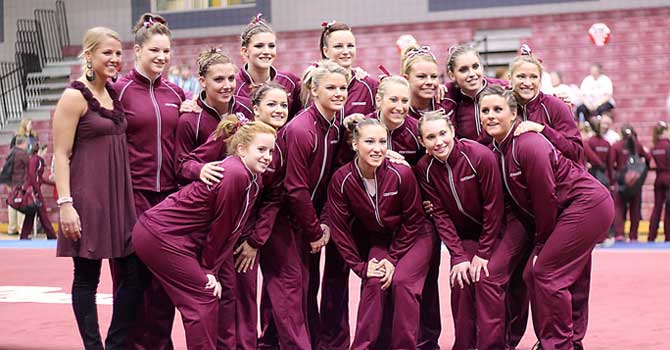
Which Are The Best Gymnastics Teams?
The Soviet Union and Japan have dominated in the second half of the 20th century especially in the artistic aerobics. Currently, Russia, China, Japan, Romania, and the United State are the top teams in the Artistic Gymnastics.
Russia and former Soviet countries like Belarus, Ukraine have acquired the most Olympic medals in the Rhythmic gymnastics.
In Trampoline Gymnastics, from Russia, China, and Canada, the Youngest Olympic Discipline has had the diverse group of medalist.
Which Are The Biggest Aerobics Competitions?
The Gymnastics Olympics held after every four years, and Artistic Calisthenics teams have five members now which began with 2012 games in London. The teams have six members in 2008 and seven members in 1996.
World Championship is the second biggest competition which held in the non-Olympic years. There were two world aerobics championships, one in 1994 for the team and for individuals, second was in 1996 that was an Olympic year.
The world championship some time held after every two years.
Other main competitions are European Championships, the Asian Games, the Pan American Games and World Cup meets.
You Might like to Read:
How to do Gymnastics at Home?
It is one of the former, most revered, and complicated sport requires strength, flexibility, equilibrium, and synchronization.
In spite of this, aerobic academies are very uncommon in most areas, and formal instructions are very expensive that make difficult to get concerned about it.
Fortunately, it is possible to acquire good fundamental gymnastic skills on your own if you are passionate and dedicated.
For further detail visit below link.
- Learn How to do Gymnastics at home
- Learn How to Make a Gymnastics Bar at home
- Learn How do you disinfect gymnastics equipment?
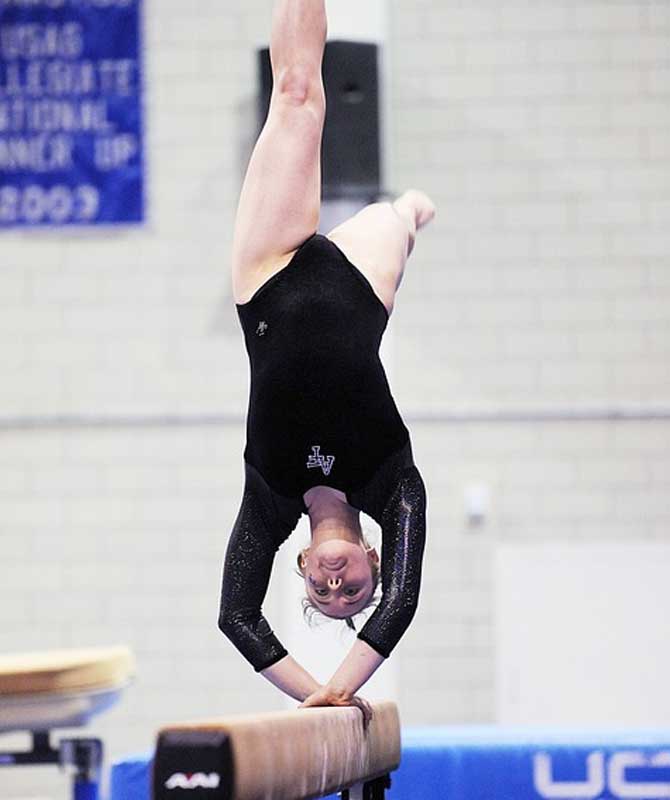
Is Gymnastics Dangerous?
Gymnastics no doubt is the most dangerous sport in the world, most wish to be a good gymnast but few ever to meet their goals. The alarming facts are as follows,
Eating Disorder
The coach frequently pressures the player for weight loss which is dangerous for the teenage children.
Injuries
It is a high impact sport, and even one misstep can provoke injury. Broken bones and sprains are common injuries among gymnasts.
The textbook “Biology: Life on Earth With Physiology” reveals that broken bones can modify growth in some cases.
Psychological Problems
Most gymnasts become isolated from their friends and family by spending the most time in training to play at the perfection level.
Negative coaching may impact on gymnast self-esteem.
Brain comes under the process of some complex cognition known as mental gymnastics.
Most children run off from school in the pursuit of gymnastics.
It would effect on the education and career.
Injury Breakdown by Body Parts
| Injury | n (%) | Injury | n (%) | Injury | n (%) |
|---|---|---|---|---|---|
| Head/neck | Elbow | Knee | |||
| Concussion | 4 (9.3) | Fracture | 17 (10.2) | ACL tear | 33 (5.3) |
| Muscle strain | 18 (41.9) | Dislocation | 10 (6.0) | MCL injury | 21 (3.3) |
| Contusion | 3 (7.0) | Strain – sprain | 54 (32.3) | Patellar tendonitis | 98 (15.6) |
| Nonspecific pain | 9 (20.9) | Tendonitis | 13 (7.8) | Patellofemoral syndrome | 97 (15.5) |
| Other | 9 (20.9) | Symptomatic OCD | 9 (5.4) | Osgood-Schlatter | 54 (8.6) |
| Total | 146 (4.0b) | Ulnar neuropathy | 11 (6.6) | Symptomatic plica | 40 (6.4) |
| Shoulder | Contusion | 9 (5.4) | Patellar subluxation | 16 (2.6) | |
| Multidirectional instability | 55 (37.7) | Nonspecific pain | 17 (10.2) | ITB syndrome | 7 (1.1) |
| Rotator cuff tendonitis | 31 (21.2) | Other | 27 (16.2) | Hyperextension injury | 35 (5.6) |
| Sprain | 15 (10.3) | Total | 167 (4.5b) | Strain | 89 (14.2) |
| AC separation | 4 (2.7) | Wrist | Contusion | 28 (4.5) | |
| Subluxation | 26 (17.8) | Dorsiflexion jam syndrome | 128 (36.5) | Nonspecific pain | 51 (8.1) |
| Contusion | 3 (2.1) | Fracture | 21 (6.0) | Other | 58 (9.3) |
| Nonspecific pain | 9 (6.2) | Strain or sprain | 66 (18.7) | Total | 627 (17.0b) |
| Other | 3 (2.1) | Symptomatic ganglion | 14 (4.0) | Leg/calf | |
| Total | 146 (4.0b) | Tendonitis | 7 (2.0) | Tibial stress syndrome | 109 (36.0) |
| Back | Contusion | 6 (1.7) | Stress fracture | 100 (33.0) | |
| Strain / sprain | 144 (35.3) | Nonspecific pain | 83 (23.6) | Strain & sprain | 19 (6.3) |
| Spondylolysis | 34 (8.3) | Other | 26 (7.4) | Contusion | 16 (5.3) |
| Suspected spondylolysis | 48 (11.8) | Total | 351 (9.5b) | Nonspecific pain | 51 (16.8) |
| Mechanical pain | 58 (14.2) | Hand | Other | 8 (2.6) | |
| Intervertebral disk | 4 (1.0) | Fractured digit | 26 (21.1) | Total | 303 (8.2b) |
| Impingement | 10 (2.5) | Dislocated digit | 4 (3.3) | Ankle | |
| Hyperextension injury | 9 (2.2) | Other fracture | 7 (5.7) | Strain o- sprain | 311 (48.1) |
| Symptomatic scoliosis | 18 (4.4) | Digit strain or sprain | 47 (38.2) | Fracture | 56 (8.7) |
| Contusion | 16 (3.9) | Other strain or sprain | 4 (3.3) | Dorsiflexion jam syndrome | 52 (8.0) |
| Nonspecific pain | 10 (2.5) | Symptomatic cyst | 4 (3.3) | Tendonitis | 22 (3.4) |
| Other | 56 (13.8) | Contusion | 10 (8.1) | Synovial pinch | 16 (2.5) |
| Total | 407 (11.1b) | Nonspecific pain | 9 (7.3) | Accessory scaphoids | 9 (1.4) |
| Chest/abdomen | Other | 12 (9.8) | Subluxing peroneals | 8 (1.2) | |
| Costalchondral separation | 7 (20.6) | Total | 123 (3.3b) | Retrocalcaneal bursitis | 6 (0.9) |
| Strain / sprain | 15 (44.0) | Hip/groin | Nonspecific pain | 75 (11.6) | |
| Contusion | 2 (5.9) | Iliopsoas tendonitis | 23 (20.0) | Other | 101 (15.6) |
| Nonspecific pain | 7 (20.6) | Snapping ITB | 19 (16.5) | Total | 647 (17.6b) |
| Other | 3 (8.8) | Strain and sprain | 33 (28.7) | Foot | |
| Total | 34 (0.9b) | Trochanteric bursitis | 8 (7.0) | Fracture | 92 (15.9) |
| Arm/forearm | Apophysitis | 8 (7.0) | Pes planus | 23 (4.0) | |
| Fracture | 7 (15.2) | Contusion | 3 (2.6) | Accessory navicular | 24 (4.1) |
| Strain – Sprain | 14 (30.4) | Nonspecific pain | 14 (12.2) | Strain & sprain | 139 (24.0) |
| Contusion | 6 (13.0) | Other | 7 (6.1) | Contusion | 96 (16.6) |
| Tendonitis | 3 (6.5) | Total | 115 (3.1b) | Bursitis | 10 (1.7) |
| Nonspecific pain | 10 (21.7) | Thigh/buttocks | Nonspecific pain | 109 (18.8) | |
| Other | 6 (13.0) | Strain / Sprain | 51 (59.3) | Other | 86 (14.9) |
| Total | 46 (1.3b) | Contusion | 8 (9.3) | Total | 579 (15.7b) |
| Nonspecific pain | 17 (19.8) | ||||
| Other | 11 (11.6) | ||||
| Total | 86 (2.3b) |
Gymnastics Injury Summary
| Body Part | No. of Injuries | Percentage of Overall Injuries |
|---|---|---|
| Head/neck | 43 | 1.2 |
| Shoulder | 146 | 4.0 |
| Back | 407 | 11.1 |
| Chest/abdomen | 34 | 0.9 |
| Arm/forearm | 46 | 1.3 |
| Elbow | 167 | 4.5 |
| Wrist | 351 | 9.5 |
| Hand | 123 | 3.3 |
| Hip/groin | 115 | 3.1 |
| Thigh/buttocks | 86 | 2.3 |
| Knee | 627 | 17.0 |
| Leg/calf | 303 | 8.2 |
| Ankle | 647 | 17.6 |
| Foot | 579 | 15.7 |
Gymnastics Injuries Statistics by National Center for Biotechnology Information
Death of Famous Gymnast
Julissa Gomez first women died on 8th August 1991. She was an American gymnast and very quickly came in the rank of elite aerobics in the mid of 1980. She was cut short by vaulting accident in 1988 and at last, died from her injury.
Which Gymnastics Event Is The Hardest:
All the artistic gymnast sports are equally challenging, but due to specific features can make some events comfortable and some much tougher.
It is different for everyone, but according to science as well as player remarks, balance beams from the female side and Pommel horse from the male side are the hardest events.
The main challenging is dynamic stability that gymnast has to hang about in balance over both events

Are Gymnastics And Cheerleading The Same Thing:
Gymnastics and cheerleading are the same things in sports point of view, but both are not same in performing, training, and its ground responsibilities. We are not capable to say which one is harder than the other.
Both have some similarities and differences as follows,
- Gymnastics is the name of consistently training and conditioning the gymnast figures because physical strength is chief. In the case of cheerleading, training is not compulsory on a daily basis.
- Both sports call for flexibility, but gymnasts require more force when it comes on the upper-body.
- Calisthenics routines are more classic than cheerleading.
- Gymnastics face seems grave and more focusing as compared to cheerleading where cheer face and super vocal is essential.
- Cheerleading makes a human pyramid and performs stunt few people at once, but in gymnasts, performance involve.
- Cheerleading is a floor routine and along working need a more upbeat and fast music. Aerobics demands entirely for focusing plus floor music with a less upbeat.
- Both sports are team vs team, but aerobics becomes individual competition when comes on the floor.
- Few things that consider illegal in cheerleading in fact required in gymnastics.
Gymnastics Equipment
Women’s Artistic Gymnastics Equipment
Women’s artistic gymnastics apparatus comprises uneven bars, balance beam, floor exercise, and vault.
- The balance beam is a 10 cm wide apparatus which is 1.5 m above the mat. The gymnast executes skill like leaps, flips, and handstand with great balance.
- The uneven bars consist of two wooden bars with an adaptable metal frame. The high bar is about to 2.4m, and low bar 1.6m above the mat and the gap between both bars is 1.8m. Both the bars can adjust according to height and preferences.
- The vault equipment is a solid platform located at the end of a 25m long runway. The gymnast performs various handsprings and jumps over the vault tool.
- For floor exercise, a 12 sqm carpeted floor comprises springs or foam padding.
Men’s Artistic Gymnastics Equipment
Men’s gymnastics apparatus include parallel bar, high bar, still rings, floor exercise, vault and pommel horse.
- The parallel apparatus contains two wooden parallel bar sustained by a metal frame. Gymnast presents several swinging and balancing skills.
- The high bar is a single bar 2.75m above the ground on a solid metal formation. The player acts swings, grips release and re-grips.
- The still rings hang with adjustable straps 50cm isolated and 2.75m above the mat.
- The pommel horse resembles vault with two handles called pommel attached to the top of a platform. The player shows strength, dexterity through coordinated hand and body movement over top of the equipment.
- The floor calisthenics equipment is as same as women flooring mat.
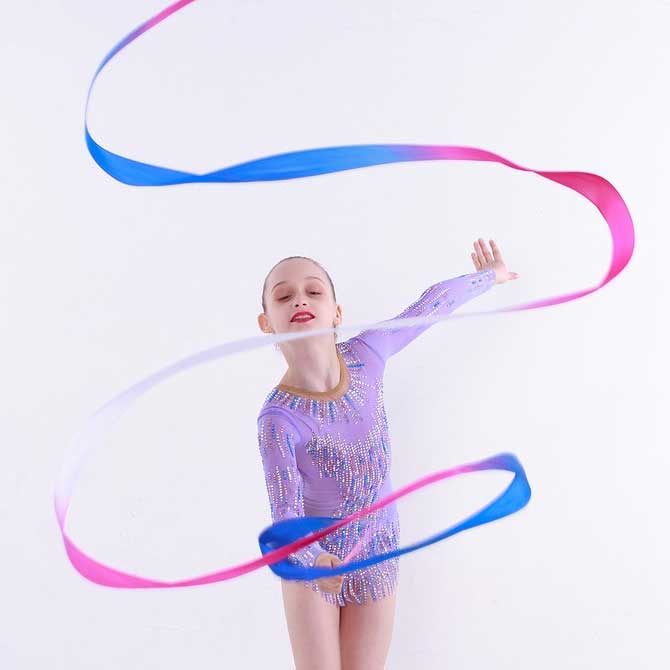
Women’s Rhythmic Gymnastics Equipment
Women’s rhythmic gymnastics apparatus consist of ball, hoop, rope, club, and ribbon. The gymnast performs each event on 13 sqm carpeted mat.
- The ball is made up of rubber or plastic with 18 to 20 cm diameter and at least 400g weight.
- The hoop stuff is wood or plastic with an inner diameter is 80 to 90 cm and 300g weight.
- The material of rope is hemp with knotted at each end.
- The gymnast uses two clubs of wood or plastic material with minimum weight is 150g per club.
- The ribbon is 7cm of satin ribbon connected with a wooden stick.
The player has to move the ribbon constantly throughout the routine.
Men And Women’s Trampoline Tools
The trampoline equipment contains a nylon spring bed attached by a metal frame. It is 5.05m long, 2.91m wide, and 1.155m high.
In this apparatus, the gymnast can reach 30 feet during bouncing and has to act challenging flips and twists.
Gymnastics Gear
Gymnastics requirements are different moves on various pieces of apparatus as the pommel horse, rings, Gymnastics bars, and vaults. By doing these actions with maximum comfort and safety minded, gymnasts have to dress in proper clothing.
The accurate clothing allows full range of motion, minimize the risk of injury which helps judges, coaches to see body movement accurately.
Here is the list of gymnastics outfit.
Leotards
Usually, gymnast use leotard doing gymnastics. It is a full-sleeved or half-sleeved and cut at the groin area like a bikini. If the gymnast doesn’t like cut, then cut can in the shape of shorts at the bottom as a substitute of a bikini.
Gymnast has to wear these outfits in the athlete competition. It must ensure that Leotard does not have any suspended accessories like a frill, strings or straps because these can get grabbed and raise the risk of injury.
Shorts
Shorts don’t require a gymnastics competition, but the player can wear throughout training. These can be dressed in with leotards, but it should not be loose because it can increase injury risk. Don’t wear those shorts which have pockets, buttons, zip or straps.
Pants
Gymnast applies long pants during their training or competition, but for sport, the pants must go with singlets instead of T-shirts. Pants generally use in the pommel horse, rings, high bar or parallel bar as protecting the skin from chafing.
T-shirts
Like shorts, T-shirts don’t allow in-game, but this is a most comfortable outfit for a male like shorts and pants. T-shirt must not be loose as well as not be tight so that it should not restrict the range of movement.
Like shorts and pants, T-shirt should not be hanging with accessories. The gymnast T-shirt must be tucked within pants or shorts.
Slippers
Mostly, gymnast, do practice bear footed, but some choose for slippers which are for gymnastics. These slippers protect the gymnast from slipping or falling during performing.
Undergarments
Most gymnasts don’t carry undergarment because Leotard outfit seems like a bathing suit does. Undergarments should be as much related that wholly cover the gear.
FAQs
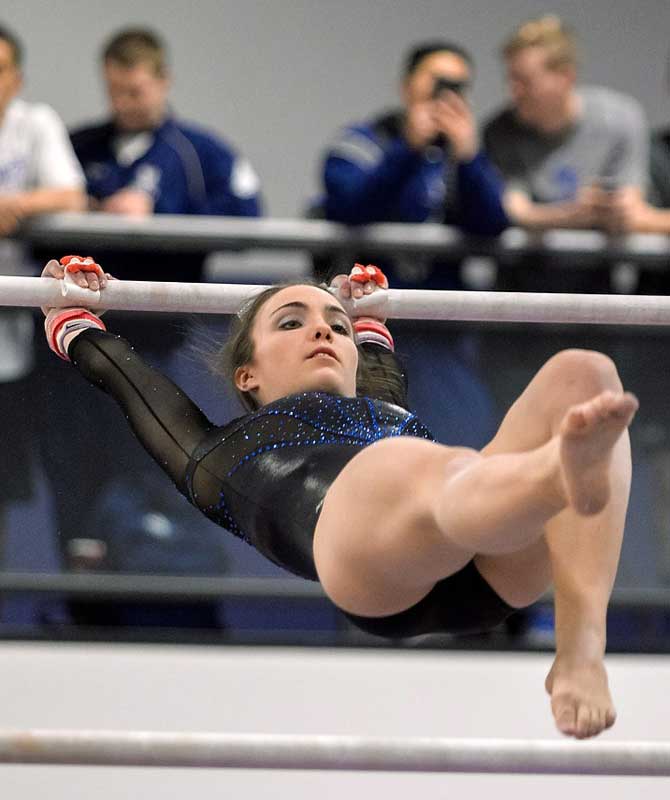
Gymnastics officially held as the sport in 1862 by United State.
First-time Gymnastics Olympic competition held in 1928.
In 1896 first time it was introduced in Olympics trials.
There are different reason to quit gymnastics.
Life’s demands.
Fear
Body’s changing
Interest changing
Social pressure
Money desire
Extra school activities
Freedom change
Jumping on trampoline (which is the form of gymnastics) is disastrous for child and can cause scoliosis.
There is controversy about this topic. Some experts believe that extreme training may setback puberty and stunt growth at young age.
A 2007 study by Erlandson and associates,
92% of the gymnast studied reached menarche before retirement from the sport, which suggests that training was not causing a stoppage in menarche.
At this point, there is no confirmed source and effect relationship between training and growth.
A migraine is a form of a headache. Most gymnasts get a massive headache during tumbling or stuff when they on the floor.
A hymen is a thin membrane and can tear from so many activities. Yes, gymnastics can effect and break the hymen.
According to the study of US National Library of Medicine National Institutes of Health, Gymnastics has the highest rate of injuries across all sports. Because body, bones, and joints take so much pressure and twisting. This injury rate can be the treason of arthritis.
“Low back pain is one of the most common ailments of a gymnast,”
Yes, it’s true gymnastics is a dangerous sport because one misstep can cause grave injuries. Stern sprains and broken bones are widespread among gymnasts.
Gymnastics is the best way to lose weight.
Gymnastics teach strength, coordination, and flexibility which are all great thing for the whole life and also do a great help in other athletics sports.
In gymnastics, due to a breaking of the dermis, skin becomes overstretch which escort to the growth of stretch marks.
Most female gymnast and dancer had marked lumbar lordosis.
In the late eighteenth- and early nineteenth-century Germany, two pioneer physical educators – Johann Friedrich Guts Muths (1759–1839) and Friedrich Ludwig Jahn (1778–1852)
formed exercises for boys and young men on equipment they had planned that ultimately led to what is measured in modern gymnastics.
Yet gymnastics equipment is the invention of Ancient Greece, but with the passage of time, many revolutionary changing has approached.
In the mid-1800s, Friedrich Jahn did a great deal to re-introduce gymnastics into German education and he became known as the ‘father of gymnastics’.
Gymnastics helps to sustain a healthy body which is a key factor to prevent abundant health diseases like asthma, cancer, obesity, heart disease, diabetes and many more.
Gymnastics routines are extra well-designed than Cheerleading routines.
Research shows that participation in gymnastics at any level put positive effects on toddler’s self esteem and allows them to resolve their problems in a better way with full confidence.
Gymnastics grips for men and women are different in size and shape but the thing to consider is comfortability.
Tumbling is a form of gymnastics which performs of the floor without any apparatus. Flips, somersaults, tucks, handstand, and handspring etc.
Gymnastics is harder than football.
Swimming is great to stay fit but it’s not toughest as compared to gymnastics.
No doubt both sports are favorite, but if we compare the harder level then gymnastics is on the top.
Well, both sports have their own specialty, but with gymnastics make the body more flexible and elegant.
Read More:
